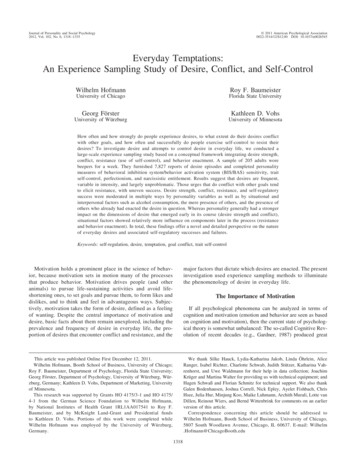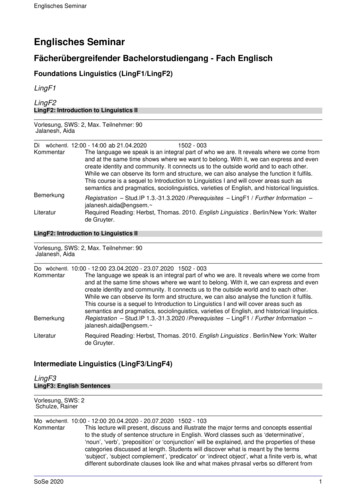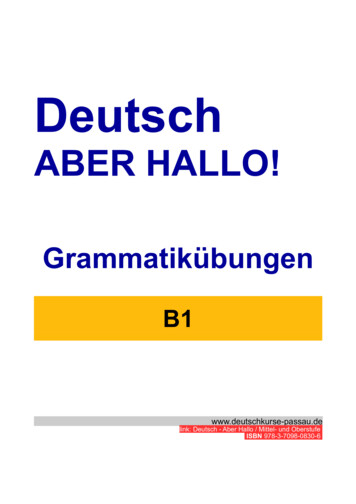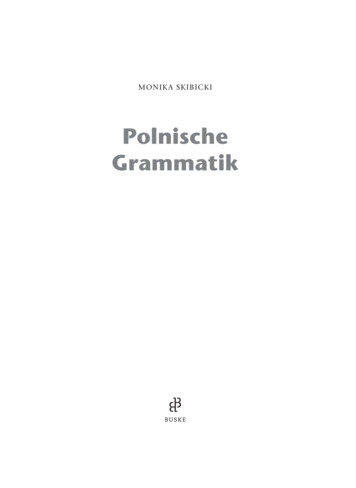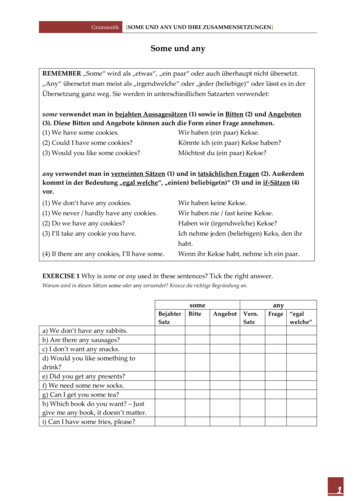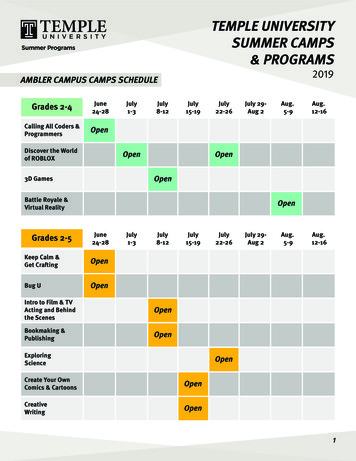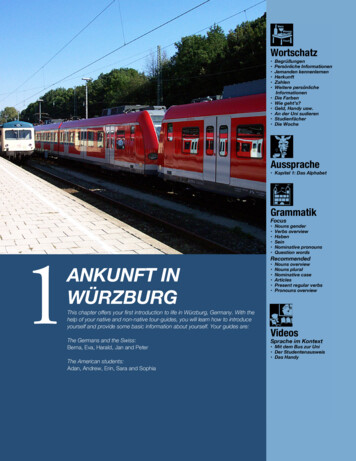
Transcription
Wortschatz BegrüßungenPersönliche InformationenJemanden kennenlernenHerkunftZahlenWeitere persönlicheInformationenDie FarbenWie geht’s?Geld, Handy usw.An der Uni sudierenStudienfächerDie Woche Aussprache Kapitel 1: Das AlphabetGrammatikFocus1ANKUNFT INWÜRZBURGThis chapter offers your first introduction to life in Würzburg, Germany. With thehelp of your native and non-native tour-guides, you will learn how to introduceyourself and provide some basic information about yourself. Your guides are:The Germans and the Swiss:Berna, Eva, Harald, Jan and PeterNouns genderVerbs overviewHabenSeinNominative pronounsQuestion words Nouns overviewNouns pluralNominative caseArticlesPresent regular verbsPronouns overviewRecommendedVideosSprache im Kontext Mit dem Bus zur Uni Der Studentenausweis Das HandyThe American students:Adan, Andrew, Erin, Sara and Sophia2017 COERLL - Germanic Studies Page 15 of 484University of Texas at Austin
Kapitel 1OnlineBook linksiYou can find a list of QR codes to access the videos directly from yoursmart device at the end of all chapters or you can go to the Deutsch imBlick website http://coerll.utexas.edu/dib/toc.php?k 1 to select your clipfrom the „Interviews“ or „Sprache im Kontext“ sections.You can find the vocabulary at:http://coerll.utexas.edu/dib/voc.php?k 1SectionsBegrüßungen GreetingsWer bist du? Who are you?Zahlen NumbersDie Farben The colorsWie geht’s? How are you? (informal)Herkunft Origin/nationalityAn der Uni studieren Studying at the universityAn die Uni fahren Getting to the universityStudienfächer MajorsDie Woche The weekYou can find the grammar topics covered in this chapter at:During the chapter exercises, you are regularly referred to GrimmGrammar at the Deutsch im Blick website. These are the grammar pointsthe chapter covers, and you need to complete all online exercises in order toget the most benefit from the exercises in this workbook. The points on the leftare necessary for completing the exercises in this course packet. The pointson the right are recommended if you need some refreshers on parts of speechor what the present tense actually is J.http://coerll.utexas.edu/gg/gr/v 02.htm Present tense of regularverbsIf you need backgroundinformation on verbsPresent tense verbs - sein Nouns - genderhttp://coerll.utexas.edu/gg/gr/no 02.html If you need some backgroundinformation on nounshttp://coerll.utexas.edu/gg/gr/no 01.htmlhttp://coerll.utexas.edu/gg/gr/det 01.html Personal pronouns nominative casehttp://coerll.utexas.edu/gg/gr/pro 02.html If you need backgroundinformation on personalpronounsQuestion words(interrogatives)Present tense verbs - habenhttp://coerll.utexas.edu/gg/gr/pro 01.html 2017 COERLL - Germanic StudiesPage 16 of 484http://coerll.utexas.edu/gg/gr/v 01.htmlhttp://coerll.utexas.edu/gg/gr/vi 11.htmlhttp://coerll.utexas.edu/gg/gr/con 05.htmlhttp://coerll.utexas.edu/gg/gr/vi 05.htmUniversity of Texas at Austin
Kapitel 1A. LISTENListen carefully to the pronunciation of each word or phrase in thevocabulary list.B. REPEATRepeat each word or phrase OUT LOUD several times until youremember it well and can recognize it as well as produce it. Make a listof the words in this chapter which you find difficult to pronounce. Yourteacher may ask you to compare your list with other students in yourclass. Make sure to learn nouns with their correct gender!Beispiel:die SprachefünfC. WRITEWrite key words from the vocabulary list so that you can spell themcorrectly (remember that it makes a big difference whether you cross theAtlantic by ship or by sheep). You may want to listen to the vocabularylist again and write the words as they are spoken for extra practice.D. TRANSLATIONLearn the English translation of each word or phrase. Cover the Germancolumn and practice giving the German equivalent for each English wordor phrase. Next cover the English column and give the translation of each.E. ASSOCIATIONSThink of word associations for each category of vocabulary. (Whatwords, both English and German, do you associate with each wordor phrase on the list?) Write down ten (10) associations with thevocabulary from the chapter.Beispiel:der Student/die Universitätdas Flugticket/das FlugzeugF. COGNATESWortschatzVorbereitungThese ideas are suggestions only. Differentlearners have different preferences andneeds for learning andreviewing vocabulary.Try several of thesesuggestions until youfind ones that workfor you. Keep in mind,though, that knowingmany words – andknowing them well,both to recognize andto produce – makesyou a more effectiveuser of the new language.Which words are cognates? (Cognates are words which look orsound like English words.) Watch out for false friends!!! Write downseveral cognates and all the false friends from the chapter, createfun sentences that illustrate similarities and differences between theEnglish and German meanings of these words.Beispiel:Nacht/nightgrün/greenFalse Friends: hell light, bright vs. Hölle hellG. WORD FAMILIESWhich words come from word families in German that you recognize (noun,adjective, verb, adverb)? Write down as many as you find in the chapter.Beispiel:das Studium (noun; studies)der Student (noun; person)studieren (verb)H. EXERCISESWrite out three (3) „Was passt nicht?” (‘Odd one out’) exercises.List four words, three of which are related and one that does not fitthe same category. Categories can be linked to meaning, grammar,gender, parts of speech (noun, verb, adjective), etc. USE YOURIMAGINATION! Give the reason for why the odd word does not fit.Your classmates will have to solve the puzzles you provide!Beispiel:grün – blau – gelb – neunHere neun does not fit, because it is anumber and all the others are colors.2017 COERLL - Germanic StudiesPage 17 of 484University of Texas at Austin
Kapitel 1BasiswortschatzCore VocabularyThe following presents a list of corevocabulary. Considerthis list as the absoluteminimum to focus on.As you work throughthe chapter you willneed more vocabularyto help you talk aboutyour own experience.To that end, a morecomplete vocabularylist can be found atthe end of the chapter. Likewise, knowingyour numbers, colorsand fields of studywill greatly aid yourachievement of Chapter 1’s objectives.(QR 1.1 p.50)BegrüßungenHallo!Guten Morgen!Guten Tag!Auf Wiedersehen!Bis morgen!Bis Samstag!GreetingsHello!Good morning.Hello! (Good Day)Goodbye! (formal)See you tomorrow.See you Saturday.Persönliche InformationenWie heißt du?/Wie ist dein Name?Wie heißen Sie?/Wie ist Ihr Name?Ich heiße Ich bin Ich bin enfindenPersonal informationWhat’s your name?What’s your name? (formal)My name is I am I am a student (m/f).to be calledto beto haveto live (reside)to go or walkto stay or remainto findJemanden kennenlernenTo meet someoneWer ist das?Who is that?vorstellento introduceFreut mich!Nice to meet you.Angenehm.(here) Pleased to meet you.Es freut mich, dich/Sie kennen zu lernen.It is nice to meet you (informal/formal).Danke.Thank you.Bitte.Please / You are welcome.Entschuldigung.Excuse me.(Es) tut mir leid. I am sorry.Ja, bitte.Yes, please.Nein, danke.No, thank you.Herkunftkommen ausWoher kommst du?die USADeutschlandÖsterreichdie SchweizAmerika (Nord-, Mittel-, Südamerika)EuropaOrigin/Nationalityto come fromWhere do you come from? (informal)the USGermanyAustriaSwitzerlandAmerica (North, Central, South America)EuropeWeitere persönliche Informationendas Jahr (Jahre)Wie alt bist du?Wie alt sind Sie?Ich bin achtzehn Jahre alt.Was ist Ihre Adresse?die Hausnummer (-nummern)die Postleitzahl (-zahlen)More personal informationthe yearHow old are you?How old are you? (formal)I am 18 years old.What is your address?house numberzip code2017 COERLL - Germanic StudiesPage 18 of 484University of Texas at Austin
Kapitel 1Wie geht’s?Wie geht es Ihnen?Sehr gut, danke!Es geht mir gut.Ausgezeichnet!Es geht mir nicht so gut.Ich bin müde.How are you? (informal)How are you? (formal)Very well, thanks.I’m doing great!Excellent!I’m not feeling well.I’m tired.An der Uni studierendas Hauptfach (-fächer)das Nebenfach (-fächer)lernenstudierender Studentenausweis (-ausweise)das Studentenwohnheim (-heime)die Toilette (Toiletten)das Studienfach (-fächer)Studying at the Universitymajorminorto learn, to study (homework, for a test, etc.)to study (major in; study at university)student ID carddormitoryrestroomsfields of studyDie g/SonnabendSonntagdas Wochenende (-enden)The ndaythe weekend2017 COERLL - Germanic StudiesPage 19 of 484BasiswortschatzCore VocabularyUniversity of Texas at Austin
Kapitel 1Sich vorstellenAktivität 1. Harald und Peter: Werbin ich?Listen to the interviews with Harald and Peter.Circle the correct answers to the questions asthey introduce themselves.(QR 1.22 p.50)HARALDHerkunft? Er kommt ausMünsterMünchenMainzAlter? Er ist15 Jahre alt25 Jahre alt50 Jahre altLieblingsfarbe? Seine Lieblingsfarbe istRotBlauBraunEr weiß esnicht.Diese Farbeist energisch.Warum? Warum ist das seine Lieblingsfarbe? Sie ist wieBayern und derHimmel (sky).(QR 1.26 p.50)PETERHerkunft? Er kommt ausder SchweizTexasStuttgartNummer? Welche Nummer sagt er?seineseineTelefonnummer HausnummerLieblingsfarbe? Seine Lieblingsfarbe istRotBlauWarum? Warum ist das seine Lieblingsfarbe?Sie ist ruhig(peaceful).Sie ist intensiv. Sie ist dieFarbe derLiebe (love).BraunAktivität 2. Wer bin ich?What are the questions? Listen to the clips with Harald and Peteragain. What questions does the interviewer ask, and what do thequestions mean?(QR 1.22 p.50)(QR 1.26 p.50)Wie heißen Sie?What’s your telephone number?Woher kommen Sie?What’s your favorite color?Wie alt sind Sie?Where are you from?Wie lautet Ihre Telefonnummer?How old are you?Was ist Ihre Lieblingsfarbe?What’s your name?Warum?Why?2017 COERLL - Germanic StudiesPage 20 of 484University of Texas at Austin
Kapitel 1Consider the questions from these two interviews. You can view the clips again as well asreview the questions in Aktivität 2. What word does the interviewer use to refer to eitherHarald or Peter?Grimm GrammarHow does the interviewer refer to “you” with these people?Your reflection on this question will be important for a later exercise.Aktivität 3. Wie heißt du?Ask several of your classmates what their names are and write them inthe box belowAt home please readthe following grammarpoint on the GrimmGrammar website.Student 1Student 2Present tense of regular verbs (also complete the activities forthis grammar point)Student 3Now tell your teacher and the rest of the class what your new classmates’ names are:Wie heißt er/sie?Er/sie heißt .Er/sie heißt .If you need some background on verbs, pleaseread http://coerll.utexas.edu/gg/gr/v 01.htmlich komm edu komm ster komm tsie komm tes komm twir komm enihr komm tsie komm enAktivität 4. Ich heiße Form a circle, and play the chain-game with the names: One studentbegins by sayingSie komm en (formal)S1: „Ich heiße ” and asks his/her neighbor on the right or left “Wie heißt du?”S2: That student says „Ich heiße ” and adds (regarding the first student) „Er/sieheißt ” and asks the next student „Wie heißt du?”.S3: The third student, in turn, says „Ich heiße ”, „Er/Sie heißt “(about the second student), „Er/Sie heißt ” (about the first student) and asks thenext student „Wie heißt du?” etc. until all students have named all their classmates.2017 COERLL - Germanic StudiesPage 21 of 484University of Texas at Austin
Kapitel 1Die ZahlenAktivität 5. Wie lautet deine Telefonnummer?Die ZahlenPlease note that theGerman numbers canbe confusing, especially the handwrittennumbers 1 and 7.And you do not wantto miss that all-important date becausea German 1 can looklike an American 7.0 1 2 3 4 5 6 7 8 9 10nulleinszweidreivierfünfsechssieben achtneunzehnA. Ask two of your classmates what their phone numbers are:Wie lautet deine Telefonnummer?Meine Telefonnummer ist:B. Now report back to your instructor:Seine/Ihre Telefonnummer ist Aktivität 6. Wichtige Adressen & Telefonnummern inDeutschlandWhen you go to German-speaking countries, you will likely need to callsomeone at some point (e.g., your school, a pizzeria, etc.). Contactinformation is often presented differently in various cultures, so it helpsto familiarize yourself with how to glean phone numbers, addresses,opening times abroad. As a first step, read the following informationand answer the questions below.Amerikanische Botschaft BerlinNeustädtische Kirchstr. 4-510117 BerlinTel.: (030) 2385 1742017 COERLL - Germanic StudiesAmerican Citizen ServicesTel.: (030) 832-9233, 14-16 Uhr, Montag bis FreitagTel. in Notfällen außerhalb der Öffnungszeiten:(030) 8305-0, Fax: (030) 8305-1215Öffnungszeiten: 8:30-12:00 Uhr, Montag bis FreitagGeschlossen an deutschen und amerikanischenFeiertagenPage 22 of 484University of Texas at Austin
Kapitel 11. What are the address and the telephone number of the American Embassy? When isits office for citizenship services open? Which days and what time? What is the phonenumber and what is the fax number?2. What is the address of the Uni Würzburg’s international student office? Where couldyou get more information about the office?3. What is the address of the pizza delivery service? What is the zip code? What is thephone number?4. What do you think Notrufnummern means? What does Feuer mean and who do youcall with the number 112?Aktivität 7. Zahlen und NummernAlthough you can list the individual digits of your phone number (andmany Germans do), a lot of people use double or triple digits like inEnglish, or as you would state your age.So, your friend’s phone number can be 0 hundertsiebzigSimilarly, your age is not 1-9 (eins neun) but rather 19 g (if it’s a send33dreiunddreißig1000000eine Million34vierunddreißig2017 COERLL - Germanic StudiesPage 23 of 484University of Texas at Austin
Kapitel 1Aktivität 8. Das AlterAsk the two classmates you’ve been working with how old they are.S1: Wie alt bist du?S2: Ich bin Jahre alt.S2: Und du? Wie alt bist du?S1: Ich bin Jahre alt.When you report back to your instructor, useEr/sie ist Jahre alt.„Zum Geburtstag viel Glück!Zum Geburtstag viel Glück!Zum Geburtstag, lieber/liebe ,zum Geburtstag viel Glück!”Aktivität 9. Wie viel kostet es?You use double and triple digits for expressing how much somethingcosts as well. Look at the following Rechnung and identify how muchwe paid for the Pizza Margherita, the „Quo Vadis” house salad, thecoke, the Pellegrino mineral water, and the espresso. Write the pricesout with words; some of the items have already been modeled for you.Die Pizza Margherita .Der Salat .Die Cola .Das Mineralwasser .Ein Espresso .Insgesamt bezahlen wir .Das Eis (der Schneemann) kostet zwei Euro fünfzig.Die Pizza Molto Forte kostet sechs Euro achtzig.Ein Glas Apfelschorle kostet einen Euro neunzig.Die Mehrwertsteuer beträgt sechs Euro fünfundsiebzig.2017 COERLL - Germanic StudiesPage 24 of 484University of Texas at Austin
Kapitel 1Grimm GrammarAktivität 10. Sprache im Kontext:Mit dem Bus zur UniKnowing your numbers comes in very handywhen you want to travel by bus, too.(QR 1.28 p.50)A. Watch the Sprache im Kontext clip with Tobias, and write down what the clip is about:What do you notice? Who is in the clip? Where does it take place? etc.At home please readthe following grammarpoint on the GrimmGrammar website.B. Watch the clip again and check all words that you hear. Verbs – sein(and complete theexercise, too) Busticket Universität Bargeld Studenten Studentenausweis bezahlen kosten fahren Fahrplanich bin – I amdu bist – you areer ist – he issie ist – she ises ist – it isC. Watch the clip again and answer the questions below.1. Which three buses go in die Stadt and to the Hubland?1101440114wir sind – we areihr seid – you all aresie sind – they areSie sind – you are (formal)14002. What do you need to get to the Hubland campus by bus?1. A bus pass, which you can buy on any bus or tram in Würzburg2. Cash (Bargeld); at least 10 Euro3. Your student ID card, which lets you travel free on any publictransportation in WürzburgD. Listen to the clip one more time. What article does Tobias use in front of thekey nouns in his message? What does the article indicate about the gender ofthese nouns?TobiasHubland 017 COERLL - Germanic StudiesPage 25 of 484University of Texas at Austin
Kapitel 1Aktivität 11. Würzburg entdeckenYou just arrived in Würzburg and even though it is not the biggest cityas you will see in the next exercise it is different than what you areused to in the US. Answer the questions on the next page using themap below.2017 COERLL - Germanic StudiesPage 26 of 484University of Texas at Austin
Kapitel 11. Wie lautet die Adresse des Studentenwerks? (Write out the numbers of the zip code.)2. Wie lautet die Telefonnummer der Jugendherberge in Würzburg?3. In welcher Straße liegt die Universität in Würzburg und welche Hausnummer hat sie?4. Deine Wohnung liegt „Am Kugelfang”. Welchen Bus/welche Busse musst du zur Uni nehmen?Aktivität 12. Und wer wohnt in Würzburg?Here are statistical information about the city of Würzburg from their website. Practice yourZahlen and try to match the nouns on the right hand side with the corresponding Germanterms in the table. You may use a dictionary. Then check with your classmates and theteacher.A. usländische Mitbürger16977155449241Einwohner je tersstrukturim Jahr 2009 bzw. 2029männlichweiblichmoves away frombirths moves tomen women citizensforeign citizenspopulation deathsB. Answer & discussWhat do you call this typeof graph?What does it tell us aboutthe city of Würzburg?Do you know how thisgraph would look like foryour city?Weitere InformationenStadt Würzburg www.wuerzburg.de2017 COERLL - Germanic StudiesPage 27 of 484University of Texas at Austin
Kapitel 1Aktivität 13. Wüzburg versus DeutschlandIn the following you will engage with more statistical data about Würzburg and Germany. TheBundesinstitut für Bevölkerungsforschung (federal institute for population research) offers avariety of tables, maps, graphs and other visualized statistics along with explanations. Visit anyof the following websites for more facts about Germany: ueber-deutschand.de or http://www.auswaertiges-amt.de.A. Compare and discuss the information about Würzburg and 82.002.400Ausländeranteil12,8%8,8%Bevölkerung mitMigrationshintergrundKeine .319 27.493 %1. What does Bevölkerung mit Migrationshintergrund mean? How is it different to Ausländeranteil?2. What is a Kita-Quote? Do you have that in your city or country?3. Which information surprise/confuse/shock you?B. What does the following statistic tell you?1. Wie heißen die Nationen auf Englisch? Welche Nation ist am meisten vertreten (mostrepresented)? Warum?2. Wie heißen die Personen aus den Ländern? Complete below and pick two more.die TürkeiÖsterreichItaliender Türkedie Türkinder Österreicherdiederd2017 COERLL - Germanic StudiesPage 28 of 484University of Texas at Austin
Kapitel 1WER BIN ICH?Aktivität 14. Wer sind sie?Watch the „Wer bin ich?” set of video clips and take notes about thenative speakers of German. Wie heißen sie? Woher kommen sie? Wiealt sind sie? Was erzählen (tell) sie uns noch?(QR 1.15 p.50)(QR 1.18 p.50)(QR 1.23 p.50)NameKommt ausAlterTelefonnummerLieblingsfarbe(warum?)You may want to use http://maps.google.de to find out where their home towns are inGermany!Aktivität 15. Was ist die Antwort?Listen to Berna’s clip again. Connect the correct questions with thecorrect answers.(QR 1.15 p.50)Wie heißt du?Rot, weil es temperamentvoll ist.Woher kommst du?(512) 749-8940Wie alt bist du?Ich heiße Berna.Was ist deine Telefonnummer?Aus Kiel.Was ist deine Lieblingsfarbe?30.2017 COERLL - Germanic StudiesPage 29 of 484University of Texas at Austin
Kapitel 1Aktivität 16. Woher kommst du und was ist deineLieblingsfarbe?Find out where your two classmates are from and what their favoritecolors are and why.NameWoher kommst du?Was ist deineLieblingsfarbe?Warum?Woher kommst du?Ich komme aus (Er/Sie kommt aus )Was ist deine Lieblingsfarbe?Meine Lieblingsfarbe ist (Seine/Ihre Lieblingsfarbe ist )Warum?Nota bene:When colors areused as adjectives todescribe something,they are not capitalized:Das Haus ist rot.ist meine Lieblingsfarbe, weil es ist.Ich komme aus .AmerikaTexasKalifornienGroßbritannienEnglandder Türkeidem IrakUngarnden chwedenNorwegenSüdafrikaIndien2017 COERLL - Germanic StudiesRot BlauGrün GelbBraun SchwarzGrau LilaRosa OrangeWeißhell t n n n n n n n u dunkelruhig/beruhigend ynamischschön (pretty)ungewöhnlich (unusual)warm/freundlich/gemütlich (friendly)glücklich/fröhlich (happy)Page 30 of 484University of Texas at Austin
Kapitel 1Aktivität 17. Wer sind die Amerikaner?Below is a similar table to the one you filled out in Aktivität 13. Go tothe Internet site again and watch the „Wer bin ich?” video clips of theAmerican students and fill out the information based on what they say.(QR 1.2 p.50)(QR 1.5 p.50)(QR 1.7 p.50)(QR 1.10 p.50)(QR 1.13 p.50)NameHerkunftGrimm GrammarAt home please readthe following grammarpoint on the GrimmGrammar website. nouns – genderAlterIf you need backgroundinformation, please seeTelefonnummer nouns – overview determiners – articlesLieblingsfarbe(warum?)Now, consider the questions posed to both the American and German speakers in Aktivität 13and 16. What word is used to refer to “you” with these people?Consider now your answer to the question as it refered to Harald and Peter in Aktvität 1 and2. What has changed? How do those two men differ from the people interviewed in Aktivität13 and 16? Write down your thoughts and discuss them with your classmates.Aktivität 18. Kurze BeschreibungenSelect any one of the interview subjects (either from the native or thenon-native speaker group) and write a brief paragraph that introducesthat person. Mention their Name, Herkunft, Alter, Telefonnummer andLieblingsfarbe. personal pronouns inthe nominative caseIf you need backgroundinformation, please read personal pronounsoverviewich – Idu – youer – hesie – shees – itwir – weihr – you guys (y’all)sie – theySie – you (formal)Er/Sie heißt . kommt ausAktivität 19. Meine KommilitonenCollect the information you jotted down about one of your classmates,and write a paragraph that introduces him or her, using the sameinformation as listed in the previous Aktivitäten.2017 COERLL - Germanic StudiesPage 31 of 484University of Texas at Austin
Kapitel 1Aktivität 20. Sprache im Kontext: Der StudentenausweisWatch the „Sprache im Kontext” clip entitled „Studentenausweis Student ID” What information you can find on a German University IDaccording to Mario?((QR 1.29 p.50))A. Watch the video and check all the words you hear Name Universität Studienfach Monate Bibliothek lesen Barcode Studiengang Vorlesung ausgehen offen VerkehrssystemB. What purposes does the Studentenausweis serve? Circle the numbers of allthe sentences that apply1.2.3.4.5.6.It’s proof of one’s status as student.It lets students take a vacation in Germany.Students can use the public transportation system (for free).It allows students to borrow books from the library.It allows students to find a course of study.It provides information about one’s course of study.C. Watch the clip again and fill in the blanks with the missingwords (they are provided on the left, out of order).Der Studentenausweis. Damit können wir jedem zeigen, dass wirsind. Es ist zum Beispiel die Universität vermerkt.Universität Würzburg. Studentenausweis. Und das ücherSemesterTicketSemesterticket bedeutet, einfach, ja, es gibt zweiSemester im Jahr und dazwischen jeweils 2 oder 3 Monate Pause in.Und mit diesem können wir im öffentlichenVerkehrsnahsystem herumfahren.Der ist darauf gemerkt, in dem wievielten Semester ichmich befinde.Und ein Barcode, damit man in der Bibliothek ausleihen kann.Zudem ist vermerkt, welchen Studiengang ich belege und was ich.Und die Vorlesungsdauer, wie lang eben das Semester .Das ist ein Studentenausweis von einer Studentin. Wie heißt sie? Wasist ihre Matrikelnummer? Was ist eine Matrikelnummer überhaupt?Wann, wo und was hat sie studiert (did she study)?2017 COERLL - Germanic StudiesPage 32 of 484University of Texas at Austin
Kapitel 1Aktivität 21. Die Uni WürzburgHere is an authentic excerpt from the actual registration form for theJulius-Maximilians-Universität in Würzburg. Fill it out according to theprompts, and you are ready to study there next summer! Keep in mind:Germans dates are written differently from American English: Day/Month/Year (e.g., 10. Mai ikelnummer/matriculation number(wird vom Studentensekretariat ausgefüllt/filled out by the Registrar s Office)Antrag auf Einschreibung / application for matriculationzum WINTER - / SOMMER – Semester.(winter term / summer term)für Studiengang/Studiengangkombination / for Course of Studies/Combination of Study Courses.Bitte beachten Sie beim Ausfüllen dieses Antrags die ERLÄUTERUNGEN und verwenden Sie Groß- und KleinschreibungKlein-schreibungsowie Umlaute (ä, ö, ü). Schreiben Sie bitte leserlich in Druckbuchstaben. To fill out this form, please notice theELUCIDATIONS and print legibly.Angaben zur Person / Personal DataName/Surname: .Geb.-Datum/Date of Birth:.Vorname/Christian name: .Geburtsort/Place of Birth: .at Birth:.Namenszusatz/Name Affix: . (z.B. Dr,./e.g. Dr.) Geburtsname/Name taatsangehörigkeit/Citizenship:bitte internationales Kfz-Kennzeichen (z.B. D, F, GB).angeben oder, chreiben’ausschreibenplease specify international licence plate number (e.g. F, GB, IR for Iran)Name und Vorname der ElternSurname an Christian name of Parents(freiwillige Angaben/voluntary data)Vater/FatherMutter/Mother.Heimatanschrift / Home Adress:Str., Nr./Adress Line 1. .PLZ, Ort/Postal code, City. .bitte internationales Kfz-Kennzeichen (z.B. D, F, GB)Zusätze/Adress Line 2angeben oder, chreibenausschreibenplease specify international licence plate number.Semesteranschrift / Address during Semester:Str., Nr./Address Line 1.Zusätze/Address Line 2 .PLZ, Ort/Postal code, City. .Korrespondenzanschrift soll seinduringduring Semester:SemesterAddressof correspondencecorrespondence shallshall be:be:Address ofHeimatanschrift/Home Address2017 COERLL - Germanic StudiesSemesteranschrift/AddressPage 33 of 484University of Texas at Austin
Kapitel 1 .@.E-Mail-Adresse/ Email Adress:regelmäßig genutzt/as far as available and regularly used )(soweit vorhanden und regelmässig(freiwillige Angaben/voluntary data)Angaben zum gewünschten Studiengang / Data for the desired Course of StudiesIch beantrage die Einschreibung in folgenden Studiengang:I apply for study in the following discipline:1.Studiengang / 1. Course of Studies (i.e., major)angestrebter Abschluss/aspired Certificate:.
needs for learning and reviewing vocabulary. Try several of these suggestions until you find ones that work for you. Keep in mind, though, that knowing many words - and knowing them well, both to recognize and to produce - makes you a more effective user of the new lan-guage. Kapitel 1 Wortschatz oeeng
